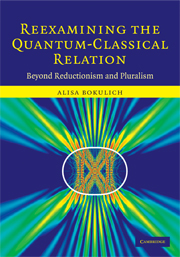Book contents
- Frontmatter
- Contents
- Acknowledgements
- Introduction
- 1 Intertheoretic relations: Are imperialism and isolationism our only options?
- 2 Heisenberg's closed theories and pluralistic realism
- 3 Dirac's open theories and the reciprocal correspondence principle
- 4 Bohr's generalization of classical mechanics
- 5 Semiclassical mechanics: Putting quantum flesh on classical bones
- 6 Can classical structures explain quantum phenomena?
- 7 A structural approach to intertheoretic relations
- References
- Index
4 - Bohr's generalization of classical mechanics
Published online by Cambridge University Press: 04 August 2010
- Frontmatter
- Contents
- Acknowledgements
- Introduction
- 1 Intertheoretic relations: Are imperialism and isolationism our only options?
- 2 Heisenberg's closed theories and pluralistic realism
- 3 Dirac's open theories and the reciprocal correspondence principle
- 4 Bohr's generalization of classical mechanics
- 5 Semiclassical mechanics: Putting quantum flesh on classical bones
- 6 Can classical structures explain quantum phenomena?
- 7 A structural approach to intertheoretic relations
- References
- Index
Summary
Something is rotten in the state of Denmark.
Shakespeare, Hamlet, Act 1 Scene 4The rise and fall of the old quantum theory
The principles of the old quantum theory were first articulated by Niels Bohr in 1913 in a three-part paper titled “On the Constitution of Atoms and Molecules.” Bohr had adopted Ernest Rutherford's model of the atom, according to which the mass of the atom is concentrated in a small central nucleus, while the electrons orbit the nucleus in planetary trajectories. The key challenge facing Rutherford's model was that it was unstable: according to classical electrodynamics, the electron, which is a moving charged body, should radiate energy and so eventually collapse into the nucleus. Bohr's solution was to incorporate Max Planck's theory of radiation, according to which “the energy radiation from an atomic system does not take place in the continuous way assumed in ordinary electrodynamics, but that it, on the contrary, takes place in distinctly separated emissions” (Bohr 1913, p. 4; BCW 2, p. 164). In this early paper, and most subsequent accounts, Bohr summarized his quantum theory by means of two assumptions or postulates. According to the first postulate, electrons cannot travel in any path they like around the nucleus, rather atomic systems can only exist in a series of discrete “stationary states,” in which the electron is in a particular allowed stable periodic orbit and is not emitting radiation.
- Type
- Chapter
- Information
- Reexamining the Quantum-Classical RelationBeyond Reductionism and Pluralism, pp. 73 - 103Publisher: Cambridge University PressPrint publication year: 2008



